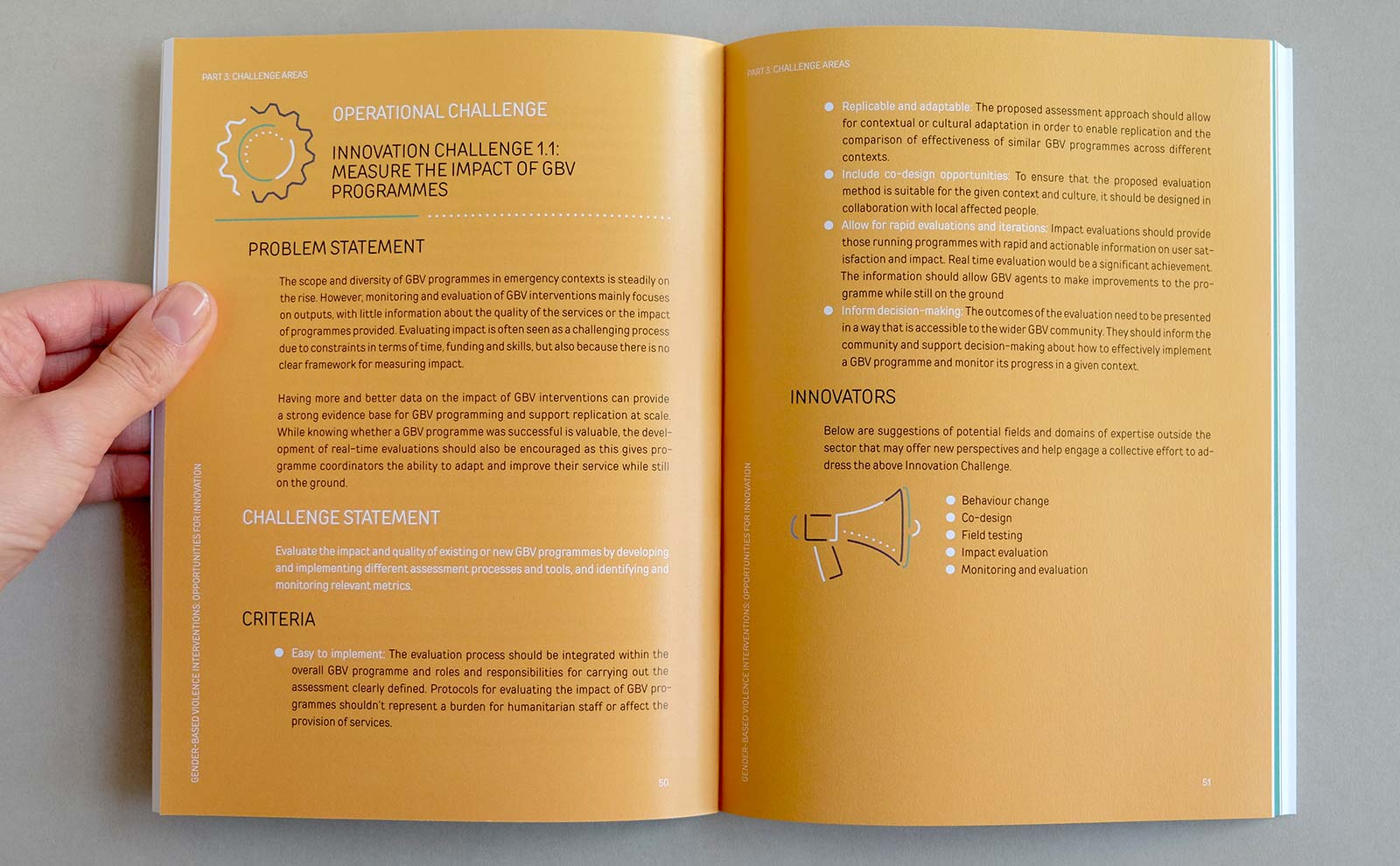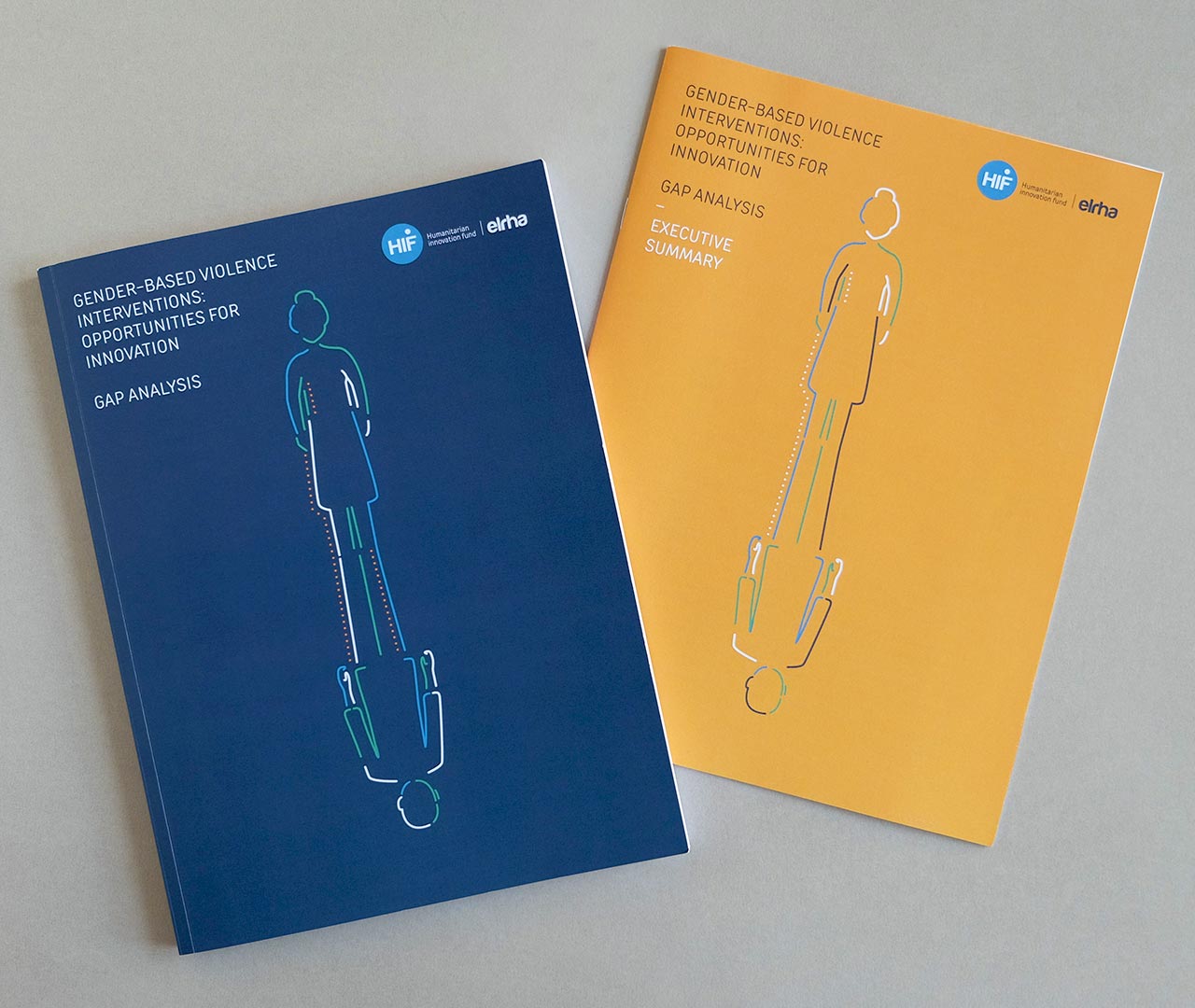Gender-Based Violence in Humanitarian Emergencies

Designing innovation challenges to improve Gender-Based Violence interventions in humanitarian emergencies
We first started working with the Humanitarian Innovation Fund (the HIF) in early 2016. The HIF is an Elrha programme that offers support to individuals and organisations that are working on innovative solutions to improve humanitarian assistance.
We helped them design and launch a number of innovation challenges in the Water, Sanitation and Hygiene (WASH) sector (more about that here). Following a fruitful collaboration, the HIF asked if we would be able to help them design something similar for their work around tackling Gender-Based Violence (GBV) in humanitarian emergencies. This is the story of that project.
The Problem
Gender-based violence (GBV) in humanitarian emergencies is a life-threatening issue. GBV impacts survivors’ immediate sexual, physical, and psychological health, and increases the risks of longer-term health problems and social stigma.
The available evidence points to the aggravation of many forms of GBV during episodes of armed conflict and natural disasters, and highlights the particular importance of effective response in such settings.
Despite this, the issue of GBV in emergencies has too often been overlooked during times of crisis, or not considered to be a humanitarian need. Effective coordination between humanitarian and development agents is lacking and, overall, there is a lack of ownership and leadership over the issue that ultimately impacts on those affected.

An example of an operational Innovation Challenge, part of the Improving Monitoring and Evaluation Challenge Area. Read about the other Innovation Challenges in the Gap Analysis.
The Starting Point
To get a better understanding of the problem and identify key gaps in existing humanitarian GBV initiatives, the HIF commissioned the Small Arms Survey (SAS) to carry out a detailed review of existing and emerging GBV initiatives humanitarian emergencies. The SAS conducted a thorough literature review, engaged with over 30 humanitarian practitioners, and held three focus groups with key stakeholders in Honduras, Nepal, and Puntland, Somalia.
Their findings highlighted the complexity of the problem, existing barriers to progress, as well as the difficulty in prioritising first steps for action.
It was at this point that the HIF reached out to us and asked if we could help translate the research findings produced by SAS into ‘actionable innovation challenges’. In simple terms, they were looking for specific problems they could set as challenges and engage a diverse community of solvers to work towards developing solutions.
Our Approach
Our work on the project began with a review of the materials produced by SAS to understand the gaps and problems identified. Being outsiders to the GBV domain, this first step allowed us to flag up terminology and knowledge that might not be familiar to a
The review helped us develop a better understanding of the complexity entailed by the topic and the dependencies between barriers holding back progress. We realised that problems ranged in scope and breadth; some targeted specific issues like the lack of
Once we started noticing patterns in the research, we created a couple of mock-ups of alternative structures for the content. We shared these with the HIF, SAS and GBV practitioners, members of the HIF’s GBV Advisory Board, for feedback. We asked questions, shared insights and, following a couple of iterations, we agreed on the following three categories to structure the research findings: Challenge Areas, Innovation Challenges, and Key Considerations.
Challenge Areas
Challenge Areas are broad problems that would benefit from a push for innovation. They are ambitious and set out a broad goal or objective that innovators can work towards.
Together with the HIF and SAS, we defined four Challenge Areas:
- Improving monitoring and evaluation;
- Increasing the availability and quality of GBV expertise;
- Improving GBV coordination and prioritization;
- Adapting standards for practical use in a variety of contexts.
In defining each of these Challenge Areas, we considered the extent to which they are able to meet the following criteria:
- Goal-driven — Have a clear, but not prescriptive, goal for innovators to work towards;
- Discrete — Are sufficiently distinct from other Challenge Areas to allow for independent progress;
- Significant — Have a goal that is ambitious, but still achievable within the given timeframe.
Within each Challenge Area we defined a number of Innovation Challenges.
Innovation Challenges
Innovation Challenges are concrete calls for action. Their goal is to clearly set out specific targets or tasks that need to be addressed in order to improve the state of GBV programming in emergencies.
In order to achieve this goal, the Innovation Challenges were designed to meet the following principles:
- Simple to understand and articulate — While a challenge is by nature difficult to solve, in order to generate interest it has to be able to be explained in a succinct and clear way;
- Genuine — It should target the causes of a problem, not the symptoms;
- Community-centred — Regardless of whether it is governments, humanitarian organisations, or individuals, a good challenge will galvanise a community of people who have been thinking about the problem for a while;
- Solvable — A challenge has to be ambitious, yet attainable. If the challenge is too broad or involves too many variables, it becomes difficult for innovators to grasp a starting point;
- Not solved already — It is often the case, especially in the humanitarian sector, for challenges to arise not because solutions do not exist, but because they are not adequately resourced in a crisis situation. In order to avoid duplicating efforts, challenges should acknowledge and build on existing efforts.
Operational vs Systemic Innovation Challenges
A further distinction was made between Innovation Challenges that were systemic in nature and those that were operational. Systemic challenges referred to areas that would require changes to the structure, organisation, or policies within the wider humanitarian system in order to generate a significant improvement. Operational challenges target a specific area within the GBV community that would benefit from particular or individual innovations. It is important to note that the distinction between operational and systemic challenges was not a firm one, nor was it a reflection of the level of difficulty of a challenge.
Each Innovation Challenge set out a clear goal that needed to be met and provided a list of criteria. The criteria were part recommendations, part ambitions meant to guide and inform innovators. For each Innovation Challenge we also considered the type of skills and collaborations that would be beneficial towards building solutions. While some challenges required mainly technical expertise, others emphasised on the need for more diverse collaborations including behavioural change experts and anthropologists, to help overcome existing barriers.
Key Considerations
Key considerations are criteria that need to be taken into account by anyone looking to improve GBV initiatives in humanitarian emergencies.
The two key considerations identified were:
- Involving local stakeholders in problem identification and solving;
- Ensuring GBV services are accessible for target groups and in
hard-to-reach areas.
Both of these considerations — accessibility and user co-design — are not necessarily barriers limiting progress, but intrinsic limitations of existing programmes. Therefore, we thought that setting them as guiding principles that need to inform the development of any kind of GBV initiatives would be most effective.
Outcomes
The direct outcome of this project was a Gap Analysis that presents problems and limitations in GBV programming in humanitarian emergencies as challenges for innovators.
The ambition of this Analysis are twofold.
Firstly, it offers a fresh perspective on innovation priorities in the area of emergency GBV programming. By doing so, it aims to inspire and engage actors and partners from different arenas to come up with new ideas on how to overcome enduring barriers.
Secondly, the Analysis represents a robust starting point for the HIF and their work around GBV in humanitarian emergencies. The Analysis sets out clear innovation pathways and represents a foundation for future and more detailed funding initiatives.
The HIF have already acted on the basis of the Gap Analysis and launched two Calls for Innovators to address the two Innovation Challenges focusing on Improving Monitoring and Evaluation of GBV.

The Gap Analysis, as well as the supporting Executive Summary are available on the HIF website. Both were designed by Poważne studio.
Reflections
This piece of work helped us understand and further refine our role in supporting funding organisations identify and prioritise problems to solve. While we were confident in our process when engaging with science topics, this project allowed us to validate our methodology with an inherently social, complex, and delicate topic. We learned that an informed outsider perspective can be extremely valuable to make sense of detailed findings, offer a new vantage point, and define priorities.
We also gained a new appreciation of how malleable the term ‘innovation’ is and how important is to define or reach an agreement about its meaning and role in different contexts. This is an important first step in establishing dialogue around what could be improved in an area and what progress should look like.

